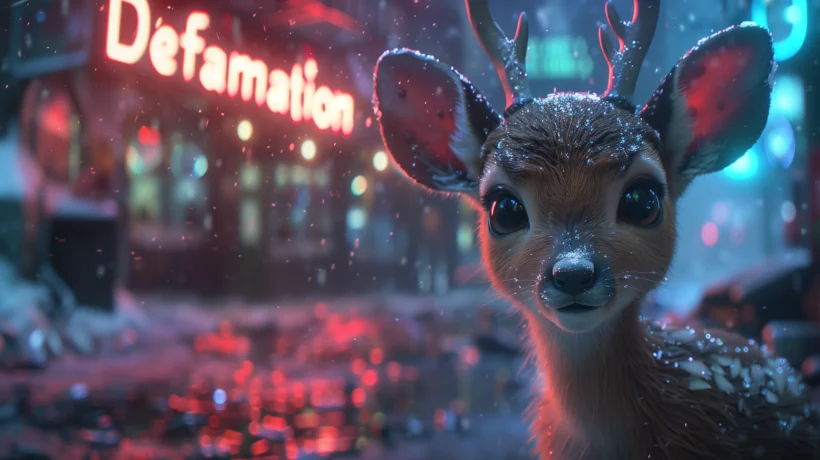
Real-life Martha is suing Netflix for $170 million over her portrayal in the series "Baby Reindeer," claiming defamation and emotional distress. The lawsuit raises significant questions about the balance between creative license and personal reputation.
by LawInc Staff
June 6, 2024
Fiona Harvey, a Scottish woman living in London, has filed a bombshell $170 million lawsuit against entertainment giant Netflix over its hit series “Baby Reindeer.” The lawsuit was filed in the U.S. District Court for the Central District of California.
Harvey alleges the show, billed as a true story, falsely depicts her as a convicted stalker and criminal who sexually assaulted and violently attacked the show’s creator. This guide breaks down the key players, claims and laws at issue in this closely-watched defamation case.
From the shocking allegations to the complex torts and first amendment arguments that will decide the case, get the inside scoop on Harvey v. Netflix and learn what it takes to bring a major defamation action against a media powerhouse.
1. The Parties Involved & Backstory
- Fiona Harvey: Fiona Harvey: The plaintiff is a Scottish woman with a law degree from the University of Aberdeen and a diploma in legal practice from the University of Strathclyde. Despite media reports referring to her as a lawyer, there is no evidence she is currently practicing. Lives in London, about 20 years older than Gadd.
- Netflix, Inc. & Netflix Worldwide Entertainment, LLC: The defendants are the producers, distributors and copyright owners of the series “Baby Reindeer.” Netflix has over 260M paid subscribers and a $283B market cap. Headquartered in Los Gatos, CA but “at home” in L.A. where it has over 1.4M sq ft of studios and offices.
- Richard Gadd: The creator and star of “Baby Reindeer” who portrays himself. A comedian in London who worked in a pub in Camden called The Heart in 2015 when he allegedly met Harvey. Admitted crack/meth/heroin user.
- “Martha”: Character in “Baby Reindeer” who is an obvious portrayal of Harvey. Depicted as a twice-convicted Scottish stalker in her 40s who sexually assaults and violently attacks Gadd.
- Baby Reindeer: 7-episode Netflix series released in April 2024, billed as Gadd’s “true story” of being stalked. Most popular Netflix show of 2024 with over 56M views so far.
Examples of Identifying Details:
- “Martha”, like Harvey, is a Scottish female lawyer 20 years older than Gadd living in London in 2015.
- “Martha” bears an uncanny physical resemblance to Harvey.
- “Martha’s” accent, manner of speaking and cadence are indistinguishable from Harvey’s.
- Within days of the show’s release, scores of people online identified Harvey as “Martha” based on her public social media history with Gadd.
Key Takeaways:
- Harvey’s identity was completely undisguised as the real “Martha” in Baby Reindeer based on multiple unique identifiers.
- Gadd admits in the show he has a need for fame so intense, he prostituted himself to advance his career in the past.
- Netflix, despite a legal duty to confirm sources on a “true story”, apparently did no fact-checking of Gadd’s claims about Harvey before airing them.
- Netflix had a clear profit motive to present a compelling story to attract and retain paid subscribers, even if it meant destroying Harvey.
FAQs:
- Is Fiona Harvey a public figure? No, Harvey is a private citizen which affects the standard of fault she must prove in a defamation case.
- Did Netflix have a duty to investigate Gadd’s claims? Yes, presenting a story as “true” creates a legal duty to take reasonable steps to verify its accuracy before publishing.
- Can Harvey sue Netflix if Gadd told them it was true? Yes, Netflix is responsible for exercising due diligence especially with such serious accusations. Reckless disregard for truth is enough to prove defamation of a private figure.
- Does Gadd’s own troubled history affect his credibility? Absolutely. As an admitted hard drug user with a confessed history of trading sex to get ahead, a jury may doubt his narrative.
- Is it illegal to base a character on a real person? Not if it’s a clearly fictional portrayal or a truthful account. But depicting someone identifiably in an alleged “true story” that destroys their reputation with false claims is textbook defamation.
2. Harvey’s Claims & Causes of Action
- Defamation: Harvey alleges Gadd/Netflix made provably false and highly damaging statements about her in Baby Reindeer, including that she was a twice-convicted stalker sentenced to nearly 5 years in prison total who violently attacked and sexually assaulted Gadd. Arguing strict liability for defamation since she’s not a public figure.
- Intentional Infliction of Emotional Distress: Claims Defendants’ conduct in smearing her as a criminal deviant to 50+ million viewers was outrageous and intended to cause severe emotional anguish, which she’s experienced.
- Negligence & Gross Negligence: Alleges Netflix had a duty of care to properly investigate “true story” claims that would foreseeably destroy her if false, but acted with gross negligence and reckless disregard by not fact-checking accusations.
- CA Common Law & Statutory Right of Publicity Violations: Asserts unauthorized use of her identity/likeness for commercial gain in “Baby Reindeer”, entitling her to disgorgement of profits and punitives under CA Civil Code § 3344 in addition to actual damages.
- Over $100M in Damages Alleged: Harvey seeks actual reputational, emotional, compensatory and punitive damages topping $100M, plus any profits from exploitation of her identity, attorneys fees and costs.
Elements of Defamation:
- A false statement of fact “of and concerning” the plaintiff;
- Published to a third party without privilege;
- With at least negligence for private figures, or actual malice for public figures;
- Causing special damages unless defamatory per se (crime, disease, unfitness for job, unchastity re: woman).
Elements of IIED:
- Extreme & outrageous conduct by defendant;
- Intended to cause plaintiff severe emotional distress or with reckless disregard of probability;
- Actual & proximate causation;
- Plaintiff suffered severe or extreme emotional distress.
Legal FAQs:
- Why are Harvey’s claims so broad? Asserting multiple torts captures all the ways she was harmed and avoids putting all eggs in one basket. Even if defamation fails, IIED or right of publicity could still prevail.
- What’s the difference between defamation per se and per quod? Presumption. Defamation per se (allegations of criminal conduct, sexual misconduct, loathsome disease or job unfitness) presumes damages. Defamation per quod requires pleading and proving special damages.
- Can opinion statements be defamatory? No, defamation requires a materially false assertion of fact, not just an opinion. But couching factual claims as opinion doesn’t make them non-defamatory.
- What’s gross negligence vs ordinary negligence? Gross negligence is an extreme departure from ordinary diligence, more than momentary thoughtlessness. Conscious indifference to risk vs carelessness.
- How are right of publicity damages measured? By commercial value of the misappropriation to defendants and injury to plaintiff. Restitution of profits, actual damages and punitives may be awarded.
3. Netflix’s Defenses & First Amendment Arguments
- Truth: The most ironclad defense to defamation is truth – if the statements made about Harvey were substantially true, her case fails. But if she can prove the key accusations were fabricated, this defense crumbles.
- Opinion: Netflix may argue certain unflattering depictions of “Martha” were opinions, exaggerations for effect, or satirical in nature rather than statements of fact. But the core claims of criminal convictions and attacks are hard to frame as opinion.
- No Actual Malice: If Harvey is deemed a limited purpose public figure, she’d have to prove Netflix knew the statements were false or had reckless disregard for truth. Her private figure status lowers the fault bar to negligence.
- Lack of Damages: Defendants may challenge the nature and extent of Harvey’s damages, arguing she can’t prove the show actually caused her quantifiable reputational or emotional injury.
- First Amendment Protections: Netflix will likely assert its free speech rights to publish on matters of public concern like crime, arguing defamation liability chills artistic expression. But speech can be punished if false.
Famous Defamation Cases:
-
- Johnny Depp v. Amber Heard (2022): Depp won $10.35M over Heard’s op-ed implying he abused her, but she won $2M for his lawyer calling her claims a “hoax.”
- Hulk Hogan v. Gawker (2016): Hogan won $140M after Gawker posted his sex tape, arguing publication wasn’t newsworthy. Bankrupted Gawker.
- Carol Burnett v. National Enquirer (1981): Burnett won $1.6M after tabloid described her as drunk and argumentative in public. Key case for media outlets’ defamation exposure.
- Hustler Magazine v. Falwell (1988): Rev. Falwell lost against Hustler for parody ad suggesting he lost virginity to his mother, as parody of public figures is protected if not depicting actual facts.
Netflix’s Best Arguments:
- Relied on Gadd’s representations as the subject of the story that his account was truthful; no reason to doubt him.
- No actual malice since didn’t have knowledge of probable falsity or reckless disregard for truth. At worst negligent failure to investigate.
- Core story of being stalked by an obsessed fan is true, even if some details were dramatized. Substantial truth doctrine.
- Some embellishment of a “true crime” story is expected by viewers and protected by First Amendment to allow artistic license.
- Harvey thrust herself into public eye by engaging with Gadd online, so is limited public figure subject to actual malice standard.
Key Defenses FAQs:
- How can Harvey overcome a truth defense? By focusing on proving the falsity of the key factual claims most damaging to her reputation, like the criminal convictions and attacks. Even if Gadd was stalked, those lies are defamatory.
- Will opinion & hyperbole arguments defeat her claims? Unlikely, as the core assertions are objectively verifiable statements of fact, not exaggeration or satire. Passing them off as “true” negates opinion defenses.
- Can Netflix blame Gadd as its source? Not really – the “wire service defense” for relying on reputable sources doesn’t apply when Netflix created the content itself. It’s responsible for the due diligence Gadd hired it to do.
- How can Harvey show actual malice if required? By proving Netflix had reason to doubt Gadd’s story but intentionally avoided the truth, or engaged in such sloppy “fact-checking” that it amounted to a reckless disregard.
- Does Harvey have a case even if parts of the story are true? Yes, if the “gist” or “sting” comes from the false criminal allegations and sexual/physical attacks. She doesn’t have to prove every unflattering detail is false.
4. Reasons This Case Is So Significant
- #MeToo Era Trial of “He Said/She Said”: With conflicting accounts between accuser and accused, case is poised to be a closely-watched battle testing credibility, standards of proof and cultural biases in the #MeToo Era.
- Astronomical Damages May Set Records: Harvey’s demand for over $100 million could result in one of the largest defamation verdicts ever against a media company for a single plaintiff if successful.
- Exposing Perverse Incentives in “True Crime” Genre: Case pulls back curtain on profit motives that may lead content creators to play fast and loose with facts for sake of compelling stories.
- Intersection of Defamation & Right of Publicity Law: Unique opportunity for court to grapple with claims that unscripted “true crime” content can violate both reputational and commercial appropriation rights.
- Implications for Limits on Embellishment in Docudramas: Could set new rules for how much fictionalization is permissible in works billed as “true stories” without running afoul of defamation law.
Potential Impacts of a Harvey Win:
- Send a chilling effect on “based on a true story” works that could stifle the creative license that fuels the entertainment industry.
- Empower more “little guy” plaintiffs to go after media giants for damaging portrayals, opening floodgate of lawsuits.
- Spur legislation to strengthen defamation laws to deter recklessly false speech even on matters of public interest.
- Force content creators to better vet sources, fact-check claims, and document due diligence before publishing “true stories.”
Potential Impacts of a Netflix Win:
- Embolden aggressive use of “anti-SLAPP” laws to swiftly defeat defamation claims, arguing they infringe free speech rights.
- Expand the boundaries of protected fictionalization in “based on true events” docudramas, allowing more dramatic license.
- Heighten the proof standards required for private figure plaintiffs to show negligence in false light or defamation claims.
- Reinforce media’s immunity from right of publicity liability when using people’s stories in expressive or newsworthy works.
Key Disputes to Watch:
- How will the court handle he said/she said evidence? Given directly conflicting accounts, expert testimony on credibility, character, motives and the overall plausibility of each side’s story may be decisive.
- Will Harvey’s criminal record be an issue? If she has any history of erratic conduct, arrests, etc Netflix will seek to admit it to undermine her reliability & damages. Expect fights over relevance & prejudice.
- What’s the line between protected opinion/hyperbole & defamatory statements of fact here? Court will have to parse dialog & context to determine if “Baby Reindeer” conveys provably false factual claims or protected exaggeration.
- Can Netflix limit damages by disputing causation? It may argue that, even if liable, much of Harvey’s distress & reputational injury stems from her own actions or unrelated issues, not their portrayal.
Summary & Conclusion

Did you know? In defamation law, public figures must prove “actual malice” to win a case, meaning the false statement was made knowingly or with reckless disregard for the truth.
The high-stakes showdown between Fiona Harvey and Netflix over its “Baby Reindeer” series is shaping up to be a blockbuster in the defamation arena. Harvey’s bold claims that the streamer smeared her as a convicted stalker and sexual/physical assailant in this alleged “true crime” story puts substantial money and reputations on the line.
With $100+ million in potential damages and major First Amendment principles at stake, this is a serious legal battle with something for everyone: sordid allegations, he said/she said drama, and complex torts at the ever-evolving intersection of defamation, privacy, publicity rights and creative expression in unscripted content.
For Harvey to prevail, she’ll need to surgically prove that the key statements most damaging to her reputation are provably false statements of fact, not just unflattering opinions or exaggerations. Showing the court a clear record of her lack of criminal history and an admission that the sexual/physical attacks never happened could go a long way. So too could evidence that Netflix failed to meaningfully vet Gadd’s story and had reason to doubt his credibility.
But Netflix has potent First Amendment arguments in reserve, poised to cast the case as an attack on artistic freedom to dramatize real life stories that touch on important issues like crime, gender power dynamics and mental health. Convincing a jury that even if elements of the story were fictionalized or mistaken, it did not act with the requisite level of fault given a reasonably diligent attempt to fact-check could be a winning strategy, particularly if Harvey’s own conduct or character is impeachable.
Ultimately, as defamation cases often do, this one will likely turn on the evidence of truth or falsity of the core factual claims and the credibility of the key players as seen through the jury’s eyes. But however it shakes out, the case is sure to break new ground at the crossroads of law and pop culture, potentially reshaping the line between protected storytelling and unprotected smears for a new era of “true crime” entertainment.

Involved in a defamation dispute over a “based on true events” story? Contact us to be connected with an experienced attorney.
Disclaimer
The information provided in this article is for general informational purposes only and not intended as formal legal advice. Laws and court interpretations may have changed since its publication. Application of the issues discussed will vary substantially across different factual and legal scenarios. Consult an experienced defamation attorney in your jurisdiction for personalized guidance on your situation.










